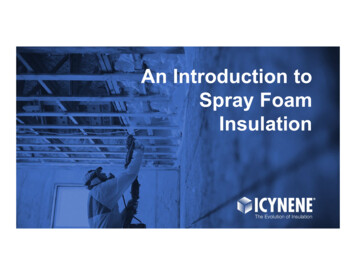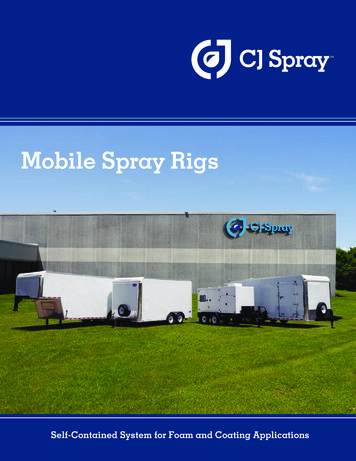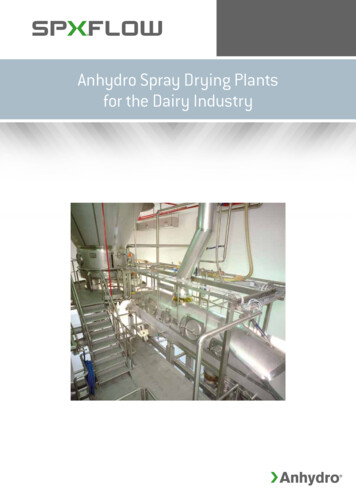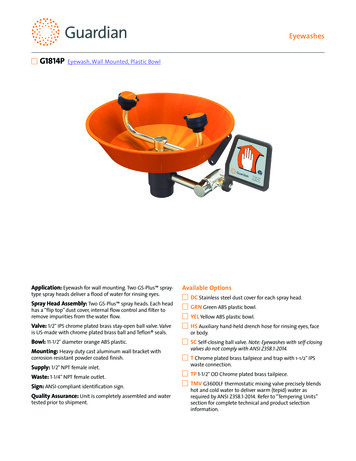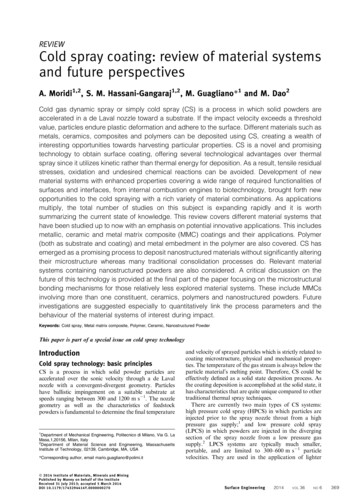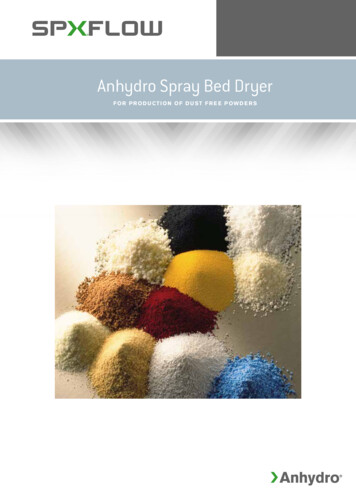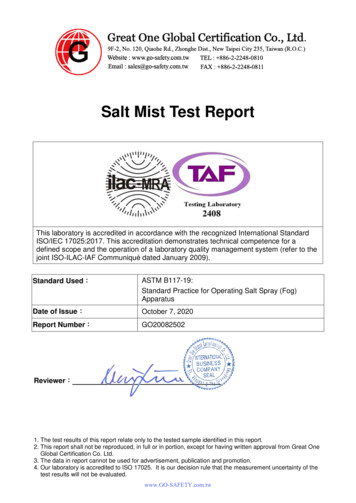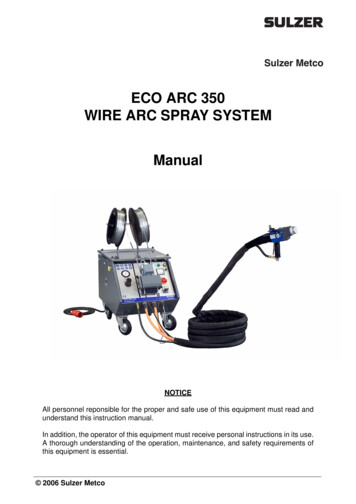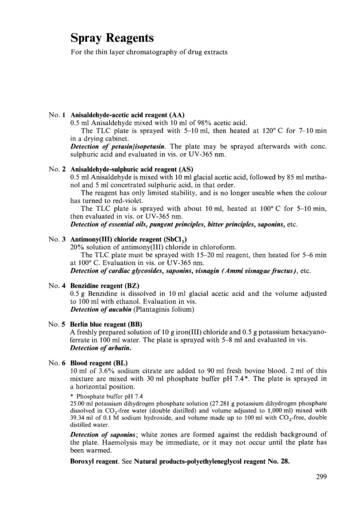
Transcription
Spray ReagentsFor the thin layer chromatography of drug extractsNo. 1 Anisaldehyde-acetic acid reagent (AA)0.5 ml Anisaldehyde mixed with 10 ml of 98% acetic acid.The TLC plate is sprayed with 5-10 ml, then heated at 120 0 C for 7-10 minin a drying cabinet.Detection 0/ petasin/isopetasin. The plate may be sprayed afterwards with conc.sulphuric acid and evaluated in vis. or UV-365 nm.NO.2 Anisaldehyde-sulphuric acid reagent (AS)0.5 ml Anisaldehyde is mixed with 10 ml glacial acetic acid, followed by 85 ml methanol and 5 ml concetrated sulphuric acid, in that order.The re agent has only limited stability, and is no longer useable when the colourhas turned to red-violet.The TLC plate is sprayed with ab out 10 ml, heated at 100 C for 5-10 min,then evaluated in vis. or UV-365 nm.Detection 0/ essential oils, pungent principles, bitter principles, saponins, etc.NO.3 Antimony(lII) chloride reagent (SbCI 3 )20% solution of antimony(III) chloride in chloroform.The TLC plate must be sprayed with 15-20 ml reagent, then heated for 5-6 minat 100 C. Evaluation in vis. or UV-365 nm.Detection 0/ cardiac glycosides, saponins, visnagin (Ammi visnagae /ructus), etc.NO.4 Benzidine re agent (BZ)0.5 g Benzidine is dissolved in 10 ml glacial acetic acid and the volume adjustedto 100 ml with ethanol. Evaluation in vis.Detection 0/ aucubin (Plantaginis folium)NO.5 Berlin blue reagent (BB)A freshly prepared solution of 10 g iron(III) chloride and 0.5 g potassium hexacyanoferrate in 100 ml water. The plate is sprayed with 5-8 ml and evaluated in vis.Detection 0/ arbutin.NO.6 Blood reagent (BL)10 ml of 3.6% sodium citrate are added to 90 ml fresh bovine blood. 2 ml of thismixture are mixed with 30 ml phosphate buffer pH 7.4*. The plate is sprayed ina horizontal position.* Phosphate buffer pH 7.425.00 ml potassium dihydrogen phosphate solution (27.281 g potassium dihydrogen phosphatedissolved in CO 2 -free water (double distilled) and volume adjusted to 1,000 ml) mixed with39.34 ml of 0.1 M sodium hydroxide, and volume made up to 100 ml with CO 2 -free, doubledistilled water.Detection 0/ saponins; white zones are formed against the reddish background ofthe plate. Haemolysis may be immediate, or it may not occur until the plate hasbeen warmed.Boroxyl reagent. See Natural products-polyethyleneglycol reagent No. 28.299
NO.7 Chloramine-trichloroacetic acid reagent (CTA)10 ml freshly prepared 3% aqueous chloramine T solution (syn. sodium sulphamidechloride, or sodium tosy1chloramide) is mixed with 40 ml of 25% ethanolic trichloroacetic acid.The plate is sprayed with 10-15 ml, heated at 100 C for 5-10 min and evaluatedin UV-365 nm.Detection of cardiac glycosides.NO.8 Dichloroquinonechloroimide reagent (DCC)1% methanolic solution of 2,6-dichloroquinonechloroimide.The plate is sprayed with 5-10 ml, then immediately exposed to ammonia vapour.Detection of arbutin (DAB 8), capsaicin (DAB 8).NO.9 Dinitrophenylhydrazine reagent (DNPH)0.1 g of 2,4-dinitrophenylhydrazine is dissolved in 100 ml methanol, followed bythe addition of 1 ml of 36% hydrochloric acid.After spraying with about 10 ml, the plate is evaluated immediately in vis.Detection of ketones and aldehydes.No. 10 DNPH-acetic acid-hydrochloric acid reagent0.2 g of 2,4-dinitrophenylhydrazine in a solvent mixture consisting of 40 ml 98%acetic acid, 40 ml 25% hydrochloric acid and 20 ml methanol.The plate is sprayed with 10 ml and evaluated in vis. It is then heated at 100 Cfor 5-10 min and evaluated again in vis. (Ph. Eur. III).Detection of valepotriates (Valerianae radix). Chromogenic dien es react withoutwarming.Remarks: Dienes can also be detected with HCL-AA reagent (No. 32).No. 11 Dragendorffreagents (DRG)Detection of alkaloids, heterocyclic nitrogen compounds, quarternary amines.No. 11A Dragendorffreagent (Ph. Eur. I, p. 139)0.85 g basic bismuth nitrate is dissolved in 40 ml water and 10 ml glacial aceticacid, followed by addition of 8 g potassium iodide dissolved in 20 ml water.No. 11 B Dragendorff reagent Rl (Ph. Eur. III, p. 105)100 g tartaric acid are dissolved in 400 ml water. 8.5 g basic bismuth nitrate areadded and the solution is shaken for 2 h. 200 ml of 40% potassium iodide arethen added, and the solution is shaken vigorously. After standing 24 h, the solutionis filtered.Diluted Dragendorff reagent (Ph. Eur. III, p. 105)50 ml Dragendorff reagent Rl are added to a solution of 100 g tartaric acid in500 ml water.No. 11 C Dragendorff reagent with tartaric acidSolution A: 17 g bismuth subnitrate and 200 g tartaric acid in 800 ml water.Solution B: 160 g potassium iodide in 400 ml water.A B stock solutionSpray reagent: 50 ml stock solution 500 ml water 100 g tartaric acid.No. 11 D Dragendorff reagent with hydrochloric acid (modified)Solution A: 0.3 g bismuth sub nitrate, 1 ml of 25% HCl, 5 ml water.Solution B: 3 g potassium iodide in 5 ml water.Spray reagent: 5 ml A 5 ml B 5 ml of 12.5% HCI 100 ml water.300
No. HE Dragendorffreagent according to VaguifalviA mixture of 2.6 g bismuth carbonate, 7 g dried sodium iodide and 25 ml glacialacetic acid is heated to boiling for a few minutes. After standing overnight, theprecipitated sodium acetate is removed by filtration. 20 ml of the c1ear red filtrateare mixed with 80 ml ethyl acetate to give the stock solution.Spray reagent: 2 ml stock solution, 5 ml glacial acetic and and 12 ml ethyl acetate.Detection limit: approx. 1 Ilg.After the plate has been dried (i.e. the smell of acetic acid is no longer detectable),it can be sprayed again with 5% ethanolic sulphuric acid, ihereby giving a ten-foldincrease in sensitivity.No. HF Dragendorffreagent,Jollowed by sodium nitrite or H Z S0 4After treatment with any type of Dragendorff reagent, the plate may be additionallysprayed with 5% aqueous sodium nitrite or with 5% ethanolic sulphuric acid, therebyintensifying the coloured zones.No. 12 Fast blue salt reagent (FBS)0.5 g fast blue salt B is dissolved in 100 ml water. (Fast blue salt B 3,3'-dimethoxybiphenyl-4-4' -bisediazonium)-dichloride)The plate is sprayed with 6-8 ml, dried and inspected in vis. Spraying may berepeated, using 0.1 M NaOH, followed again by inspection in vis.Detection of bitter principles /rom hops, and phenolic compounds in general.No. 13 Fast red salt reagent (FRS)0.5% aqueous solution of fast red salt B ( diazotized 5-nitro-2-aminoanisole).The plate is sprayed with 10 ml, followed immediately by either 0.1 M NaOHor exposure to ammonia vapour.Detection 0/ amarogentin.No. 14 Iron(III) chloride reagent (FeCI 3 )10% aqueous solution.Spray with 5-10 ml and evaluate in vis.Detection %leuropein; carnosolic acid (Salviae folium, Rosmarini folium); hop bitterprinciples.No. 15 EP reagent according to Stahl (EP)0.25 g of 4-dimethylaminobenzaldehyde is dissolved in a mixture of 45 ml of 98%acetic acid, 5 ml of 85% o-phosphoric acid and 45 ml water, followed by 50 mlconc. sulphuric acid with cooling.The sprayed plate is evaluated immediately in vis., or after heating.Detection 0/ azulenes (Matricariae flos) ; the natural blue of the azulenes is intensifiedby EP reagent. After warming at 100 C for 3-5 min, proazulene gives a blue-green(vis.).No. 16 Acetic anhydride-sulphuric acid reagentLiebermann-Burchard reagent (LB)5 ml acetic anhydride and 5 ml conc. sulphuric acid are added carefully to 50 mlabsolute ethanol, while cooling in ice. The reagent must be freshly prepared.The sprayed plate is warmed at 100 C for 5-10 min, then inspected in UV365 nm.Detection oftriterpenes, steroids (saponins, bitter principles).No. 17 Iodine-chloroform reagent (I/CHCI 3 )0.5% Iodine in chloroform.301
The sprayed plate is warmed at 60 C for ab out 5 min. It may be evaluatedimmediately, or after standing for 10 min at room temperature.Detection o/Ipecacuanha alkaloids.No. 18 Iodine re agentAbout 10 g solid iodine are spread on the bottom of a chromatography tank. Compounds containing conjugated double bonds give yellow-brown (vis.) zones on exposure to the atmosphere of iodine vapour.No. 19 Iodoplatinate re agent (IP)0.3 g hydrogen hexachloroplatinate (IV) hydrate is dissolved in 100 ml water andmixed with 100 ml of 6% potassium iodide solution.The plate is sprayed with 10 ml and evaluated in vis.Detection o/nitrogen-containing compounds, e.g. alkaloids (blue-violet). For the detection of Cinchona alkaloids, the plate is first sprayed with 5% ethanolic H Z S0 4(No. 34), and then with IP reagent.No.20 Iodine-hydrochloric aicd reagent (I/HCl)1 g potassium iodide and 1 g iodine are dissolved in 100 ml ethanol (soln. I). 25 mlof 25% HCI are mixed with 25 ml of 96% ethanol (soln. Ir).The plate is first sprayed with 5 ml soln. 1, followed by 5 ml soln. Ir. Dark brown(vis.) zones are produced.Detection o/the purine derivatives, caffeine, theophylline and theobromine.No.21 Potassium hydroxide (KOH)5% or 10% Ethanolic potassium hydroxide (Bornträger reaction)The plate is sprayed with 10 ml and evaluated in vis. or in UV-365 nm, withor without warming.Detection 0/ anthraquinones (red), anthrones (yellow, UV-365 nm); coumarins (blue,UV-365 nm).No. 22 Potassium permanganate-sulphuric aicd re agent (PPM)0.5 g Potassium permanganate is dissolved carefully in 15 ml conc. sulphuric acid,while cooling in ice (Care! Explosive manganese heptoxide is formed).Detection 0//enchone; the plate is sprayed first with phosphomolybdic acid reagent(PMA No. 27) (10 min/ll0 C), followed by PPM reagent (5 min/110 C) blue (vis.).No.23 Kedde reagent (Kedde)5 ml freshly prepared 3% ethanolic 3,5-dinitrobenzoic acid are mixed with 5 mlof2 M NaOH.The plate is sprayed with 5-8 ml of the freshly prepared mixture, then evaluatedin vis.Detection 0/ cardenolides.No. 24 Komarowsky re agent (KOM)1 ml of 50% ethanolic sulphuric acid and 10 ml of 2% methanolic 4-hydroxybenzaldehyde are mixed shortly before use.The sprayed plate is heated at 100 C for 5-10 min under constant observation,and evaluated in vis.Detection 0/ essential oils, pungent principles, bitter principles, saponins, etc.Liebermann-Burchard reagent (LB), see Acetic anhydride-sulphuric acid reagentNo. 16No. 25 Marquis re agent3 ml formaldehyde are diluted to 100 ml with conc. sulphuric acid. The plate isevaluated in vis., immediate1y after spraying.Detection o/morphine, codeine, thebaine.302
No. 26 Millons reagent (ML)3 ml mercury are dissolved in 27 ml fuming nitric acid, and the solution dilutedwith an equal volume of water.Detection 0/ arbutin and phenol glycosides in general.No. 27 Phosphomolybdic acid reagent (PMA)20% ethanolic solution of phosphomolybdic acid. The plate is sprayed with 10 ml,then heated at 100 0 C for 5 min, under observation.Detection 0/ components 0/ essential oils.For the detection of rhaponticosides: 4 g phosphomolybdic acid are dissolved withwarming in 40 ml water. 60 ml conc. sulphuric acid are added carefully to the cooledsolution. Rhaponticoside and Deoxyrhaponticoside form strong, blue (vis.) zones.No. 28 Natural produets-polyethylenglyeol reagent (NP/PEG)The plate is sprayed with 1% methanolic diphenylboric acid-ß-ethylamino ester ( diphenylboryloxyethylamine) (NP), followed by 5% ethanolic polyethyleneglycol4000 (PEG) (10 ml and 8 ml, respectively).Detection 0/flavonoids, aloin. Intense fluorescence is produced immediately or after15 min in UV-365 nm. PEG increases the sensitivity (from 10 Ilg to 2.5 Ilg). Thefluorescence behaviour is structure-dependent.No. 29 Ninhydrin reagent (NIH)30 mg ninhydrin are dissolved in 10 ml n-butanol, followed by 0.3 ml of98% aceticacid. After spraying (8 10 ml), the plate is heated for 5 10 min under observation,and evaluated in vis.Detection 0/ amino acids, biogenie amines.No. 30 Nitrosodimethylaniline reagent (NDA)10 mg Nitrosodimethylaniline are dissolved in 10 ml pyridine, and used immediatelyto spray the TLC plate.Detection 0/ anthrone derivatives (grey-blue zones in vis., e.g. from freshly harvestedFrangulae cortex).No.31 Phenylenediamine reagent (PD)0.5% ethanolic solution.Evaluation in vis. or in UV -365 nm.Detection o/constituents of Lichen islandicus (e.g. fumarprotocetraric acid).No.32 Cone. hydroehlorie acid-glacial aeetie acid reagent (HCl/AA)8 parts conc. hydrochloric acid and 2 parts glacial acetic acid.After spraying, the plate is heated at 110 0 C for 10 min, and evaluated in vis. orin UV-365 nm.Detection o/valepotriates with diene structure (halazuchrome reaction).No. 33 Nitrie acid (HN0 3 conc.)Detection 0/ ajmaline and brucine, red in vis.Detection of sennosides: after spraying with HN0 3 conc. and heating for 15 minat 120 0 C, the plate is sprayed with KOH reagent (No. 21).Red-brown (vis.) or yellow-brown fluorescent (UV-365 nm) zones are formed.No. 34 Sulphurie aeid (HZS04)A) 5% or 10% ethanolic H Z S0 4B) 50% ethanolic H Z S0 4C) concentrated H Z S0 4303
The plate is heated at 100 C for 3 5 min, and evaluated in vis. or in UV-365 nm.With conc. H 2 S0 4 coloured (vis.) zones often appear immediately.Detection of e.g. cardiac glycosides.No.35 Trichloroacetic acid-potassium hexacyanoferrate-iron(m) chloride reagent (TPF)Solution 1: 25% trichloroacetic acid in chloroform.Solution 2: 1% aqueous potassium hexacyanoferrate mixed with an equal volumeof 5% aqueous iron(lII) chloride. The plate is sprayed vigorously with solution 1and heated at 110 C for 10 min. It is then sprayed with solution 2 and evaluatedin vis.Detection of sinalhin and sinigrin.No. 36 Vanillin-phosphoric acid reagent (VPA)A:l g vanillin dissolved in 100 ml of 50% phosphoric acid.B: 2 parts 24% phosphoric acid and 8 parts 2% ethanolic vanillic acid.After spraying with either A or B, the plate is heated for 10 min at 100 C, andevaluated in vis. or in UV -365 nm.Detection of e.g. terpenoids, lignanes and cucurbitacins.No. 37 Vanillin-hydrochloric acid reagent (VHCl)The plate is sprayed with 5 ml of 1% ethanolic vanillin, followed by 3 ml conc.HCI, then evaluated in vis. Colours are intensified by heating for 5 min at 100 C.Detection of myrrh constituents.No. 38 Vanillin-sulphuric acid reagent (VS)5% Ethanolic sulphuric acid (solution I)1% Ethanolic vanillin (solution II)The plate is sprayed vigorously with 10 ml solution I, followed immediately by5 10 ml solution II. After heating at 110 C for 5 10 min under observation, theplate is evaluated in vis.Detection of e.g. components of essential oUs (terpenoids, phenylpropane derivatives,phenols, etc.).No.39 Van URK reagent0.2 g of 4-dimethylaminobenzaldehyde is dissolved in 100 ml of 25% HCI with theaddition of 1 drop of 10% iron(III) chloride solution.Detection of Secale alkaloids.304
Abbreviations and Definitions1. AhhreviationsTLC: thin layer chromatographySilica gel 60: specific surface area 500 cm 2 jg; pore volume 0.75 cm 3 jg; pore diameter60 A.UV-254 nm: shorter wavelength ultraviolet light, used to detect substances thatquench fluorescence (Silica gel 60F 254 pre-coated TLC plates from Merck, Darmstadt). Zones appear dark blue against a yellow-green fluorescent background.UV-365 nm: for the detection of substances that fluoresce in long wave ultravioletlight. UV-Iamps: commercially available lamps or tubes from Philips, Osram, Sylvania and others.vis.: visible light or daylight.2. General conceptsWithout chamber saturation: the chromatography solvent is poured into the chromatography tank, and swirled around vigorously for a few seconds. The TLC plateis then placed in position, and chromatography allowed to proceed.With chamber saturation: the solvent is allowed to remain in the c10sed tank forIjr1 h before chromatography. The inside of the tank should be lined with filterpaper.Volume of chromatography solvent: about 100 ml are normally used. Chromatography tank dimensions: 20 x 9 x 20 cm.3. Extraction proceduresPowdered drugs are used for extraction. According to DAB 7, "medium finepowder" corresponds to sieve No. 5 (0.315 mm mesh). According to Ph. Eur. I,medium fine corresponds to sieve No. 300 (mesh size 300).Sampie weights quoted for drug extraction refer to the dried drug.4. Sampie volumeThe volumes quoted are recommended averages. Depending on the quality of thedrug, larger and smaller volumes should also be used. Exact volumes can be appliedwith the aid of commercially available, standardized capillaries. If melting pointcapillaries are used, it can be assumed that 1 cm is roughly equivalent to 4-5 j.ll.As a rule, the sampie should be applied to the start as a line about 1 cm wide.Small sampie volumes (1-3 j.ll), however, are applied as a spot.305
ReferencesBooks on TLC Techniques and on the Constituents of Plant DrugsRanderath, K.: Dünnschicht-Chromatographie, 2. Aufl., Verlag Chemie, 1965Stahl, E.: Thin-Layer Chromatography 2nd. edtn., Springer Verlag, Berlin-Heidelberg-NewYork,1969Stahl, E., Schild, W.: Pharmazeutische Biologie, 4. Drogenanalyse 1I, Inhaltsstoffe und Isolierungen. Fischer Verlag Stuttgart-New York, 1981Wicht!, M.: Die Pharmakognostisch-Chemische Analyse. Untersuchung und Wertbestimmungvon Drogen und galenischen Präparaten. Akademische Verlagsgesellschaft, Frankfurt/M.,1971Wagner, H.: Pharmazeutische Biologie, 2. Drogen und ihre Inhaltsstoffe, 2. Aufl. Fischer Verlag Stuttgart-New York, 1982Wagner, H., Bladt, S.: Pharmazeutische Biologie, Praktikumshandbuch, 2. Ausg., Institut fürPharmazeutische Biologie der Universität München, 1979PharmacopoeiasDeutsches Arzneibuch, 8. Ausgabe 1978. Deutscher Apotheker Verlag, Stuttgart.Govi Verlag, Frankfurt/Main. (German Pharmacopoeia, 8th. edition 1978)Deutsches Arzneibuch, 7. Ausgabe 1968. 1. Nachtrag 1974, 2. Nachtrag 1975.Deutscher Apotheker Verlag, Stuttgart. Govi Verlag, Frankfurt/Main. (GermanPharmacopoeia, 7th. edition 1968, 1st. supplement 1974, 2nd. supplement 1975)DAB 8DAB 7Ergänzungsbuch zum Deutschen Arzneibuch. Sechste Ausgabe (Arzneimittel, dieim Deutschen Arzneibuch, 6. Ausgabe, nicht enthalten sind). (Supplement tothe 6th. edition of the German Pharmacopoeia, containing material that wasnot inc1uded in the 6th. edition)Erg.-B.6Europäisches Arzneibuch, Band I-IlI, 1974, 1975, 1978,. Deutscher ApothekerVerlag, Stuttgart. Govi-Verlag, Frankfurt/Main. (Ph. Eur. I: pp. 79-82 ThinLayer Chromatography) (European Pharmacopoeia, Volumes I-IH, 1974, 1975,1978Ph. Eur.Arzneibuch der Deutschen Demokratischen Republik. 2. Ausgabe 1979, Akademie Verlag, Berlin. (Physical analysis: 12.01 Thin layer chromatography) (Pharmacopoeia of the German Democratic Republic)2. AB-DDRDeutscher Arzneimittel-Codex, 1979 (Ergänzung zum Arzneibuch). Govi-Verlag,Frankfurt/Main. Deutscher Apotheker Verlag, Stuttgart. (Appendix E: Azeotropic solvent mixtures for TLC and paper chromatography). (German pharmaceutical codex, 1979 (supplement to the Pharmacopoeia))DACÖsterreichisches Arzneibuch, Ausgabe 1981. Österreichische Staatsdruckerei,Wien (Austrian Pharmacopoeia)ÖABPharmacopoea Helvetica, Editio sexta, 1971 und Supplement. EidgenössischeDrucksachen- und Materialzentral, Bem (Swiss Pharmacopoeia, 6th. edition,1971 and supplement)Helv. VIKommentar zum Helv. VI pp. 98-105. Erläuterungen zur Dünnschichtchromatographischen Prüfung. Selbstverlag des Schweizerischen Apotheker-Vereins, Bem1975 (Notes on Helv. VI, with guide to thin layer chromatography)The Uni ted States Pharmacopeia, 1980. The National Formulary. The UnitedStates Pharmacopeial Convention, Rockville, MD ("Chromatography" pp. 938946USPXXNFXV307
Subject IndexPage numbers referring to the description of chromatograms are printed in bold type.Abies species 16, 46Abrotani herba 149, 156Absinthii herba 128, 134absinthin 128,131,134acacetin rutinoside 180acacia flowers 165, 180Acaciae flos 165, 180Acanthopanax senticosus 227acevaltrate 264, 265, 266acid amides 55, 62aconite root 57Aconiti herba/tuber 57, 84aconitine 57, 64, 84Aconitum napellus 57Acorus calamus 9Adonidis herba 198,214,218adonis 198Adonis vernalis 198adonitoxin 198, 202, 218adonivernith 218adynerin 198,212aesculetin 150aesculin 227,230,234,242Aesculus hippocastanum 227Aetherolea 5Aetheroleum- Anisi 9,26- Anisi stellati 9, 26- Anthemidis 11,32- Aurantii 15,44- Basilici 10, 26- Calami 9, 24- Cardamomi 11, 30- Carvi 10,30- Caryophylli 10,28- Chamomillae 11, 32- Cinnamomi 9,24- Ci tri 15,44- Citronellae 14,40- Cinae 12, 34- Curcumae 14, 42- Eucalypti 13, 38- Foeniculi 9, 26- Juniperi 11,30- Lavandulae 12,34- Macis 10, 28- Matricariae 11, 32- Melissae 14,40- Menthae 12,36- Myristicae 10,28- Petroselini 10,28- Pi ni 15, 16,46- Rosmarini 11, 30- Salviae 13, 38- Sassafras 10, 26- Serpylli 14, 40- Terebinthinae 16,46- Thymi 13, 40ajmaline 55, 62, 68,70ajowan fruits 14,40Ajowani fructus 14,40albopetasin 192alder buckthorn bark 98, 106al der buckthorn fruits 98, 106Alexandrian sennapods 99alkaloid drugs 51allicin 255alliin 255Allium sativum 255, 256allyl thiourea derivatives 256allylisothiocyanate 255allyltetramethoxybenzene 10, 20, 28Aloe species 97, 102aloe-emodin 97, 102aloes 97, 102aloesine A, B 97, 100, 102aloin A, B 97, 100, 102aloinoside A, B 97, 100, 102Althaea rosea 270amarogentin 127, 130, 136amaropanin 136amaroswerin 136amentoflavone 119,122,170amide pungent principles 248amino acids 255, 288Ammi (Amme os) fructus 148, 160Ammi majus, A. visnaga 148anabsinthin 128, 134anethole 9, 20, 26Angelica archangelica 147309
angelica root 147, 154Angelica sylvestris 147anise 9Angelicae radix 147, 154anisaldehyde 9, 20, 26Anisi fructus 9,26Anisi stellati fructus 9, 26Anserinae herba 168, 186Anthemidis flos 11, 32, 165, 182, 184Anthemis nobilis 11anthocyanins 269,272, 274anthracene drugs 93anthracene glycoside drugs 97anthraquinones 93anthrone, anthranol 93apigenin 170apiol 10, 20, 28arbutin 119,120arbutin drugs 117, 120Arctostaphylos uva-ursi 119Armoracia rusticana 253, 255Arnica chamissonis 165arnica flowers 165Arnica montana 165Arnicae flos 165,174,176Artemisia abrotanum 149Artemisia absinthium 128Artemisia cina 12artichoke 129Asa foetida 148, 158asafetida 148asaresitannol 148asarone 9, 20, 24ash bark 149Asperulae herba 149, 156aspidosperma bark 55Atropa belladonna 59atropine 59, 63, 88, 90Aucuba japonica 128aucubine 128, 130, 136Aurantii flos 15, 44Aurantii pericarpium 15, 44, 129, 132,169, 188Avena sativa 229avenacoside 242Avenae herba 229, 233, 242azulene 32baldrinal 265balsams 16, 48Balsamum peruvianum 17,48Balsamum tolutanum 17, 48barberry bark 57basil 10,26Basilici herba 10, 26310bearberry leaves 119Belladonnae folium 59,88,90belladonna leaves 59belladonna root 59Belladonnae radix 59, 90Belladonnae semen 90benzo-o:-pyrones 145benzoic acid 16, 48benzoins 16, 48benzyl benzoate 48Berberidis radix 57, 80berberine 57, 63, 80Berberis vulgaris 57bergamot oil 15,44bergapten 154bergenia 119Bergenia crassifolia 119Betula species 167Betulae folium 167, 182, 229birch leaves 167bisabolol 11, 21, 32bisabolol oxide A, B 11,21,32bitter principle drugs 125blackthorn flowers 167blessed thistle 128boldine 57,61,84Boldo folium 57,84bornyl acetate 15, 19,46bilberry leaves 119Brassica nigra 255broom 58, 168brucine 56, 62, 72bryomarid 138Bryoniae radix 129, 138bryony root 129buckbean 128buckthorn berries 98bufadienolides 195Bulbus scillae 199,222burnet root 148butanone phloroglucides 279, 282cacao seeds 58Cacao semen 58,86Cacti flos 165, 176cactin 165caffeic acid 152, 171caffeine 58, 59, 65, 86caffeine drugs 86Calami rhizoma 9,24Calendula officinalis 166Calendulae flos 166, 174, 176Calluna vulgaris 119Camellia sinensis 59cannabidiol (CBD) 260
cannabidiol acid (CBDA) 260cannabinol (CBN) 260Cannabis herba 260Cannabis sativa 259cape aloes 97, 102capsaicin 249,250Capsici fructus 248, 250Capsicum annum var. longum 248Capsicum frutescens 248capsicums 248caraway 10Cardamomi fructus 11, 30cardamoms 11cardenolides 195cardiac glycoside drugs 195Cardui benedicti herba 128, 134Cardui mariae fructus 169, 190carnosol 13, 142carnosolic acid 142Carum carvi 10carvacrol 13, 19,40Carvi fructus 10, 30carvone 10, 19,30caryophyllene 28Caryophylli flos 10,28Cascarae cortex 97, 104cascarosides 97, 100, 104Cassia angustifolia 99cassia cinnamon 24Cassia senna 99catechin 122catharticin 98, 106cat's foot flowers 167cayenne pepper 248Centaurea cyanus 270Centaurii herba 127, 132Centaurium minus 127centaury 127cephaeline 56, 61,76Cephaelis acuminata 56, 76Cephaelis ipecacuanha 56,76Cereus grandiflorus 165Cetraria islandica 279Cetraria tenuifolia 279cetraric acid 281, 284Ceylon cinnamon 9,24Chamaemelum nobile 11chamazulene 11, 21, 32chamomile flowers 11, 166chamomile flowers (Roman) 11, 166Chamomilla recutita 11Chamomillae flos 11,32, 166, 184chelerythrin 57, 63, 82Chelidonii herba 57, 82chelidonine 57, 63,82Chelidonium majus 57Chinae cortex 56, 74chlorogenic acid 171, 172Chrysanthemum species 279chrysophanol 98, 100, 108Cinae flos 12,34Cinchona alkaloids 56Cinchona bark 56Cinchona ledgeriana 56, 74Cinchona succirubra 56, 74Chinchonae cortex 56,74cinchonidine 56, 61, 74cinchonine 56, 61, 74cineole 19,22,38cinerin I, Ir 279, 281, 282cinnamaldehyde 9, 20, 24cinnamein 17, 20, 48Cinnamomi cortex 9,24Cinnamomum species 9cinnamon bark 9cinnamoyl benzoate 16cinnamoyl pigments 42circular TLC 95, 112, 114citral 14, 19,40Citri pericarpium 15,44, 169, 188Citronellae aetheroleum 40citronellal 14,19,40Citrus species 15Claviceps purpurea 55clove oil 10, 28cloves 10Cnici herba 128, 134cnicin 128, 131, 134Cnicus benedictus 128codeine 56,61,78Coffea arabica 58Coffeae semen 58, 86coffee beans 58cola seeds 59Colae semen 58Colchici semen 57, 82colchicine 57, 64, 82Colchicum autumnale 57Colchicum seeds 57Colombo radix 57,80Colombo root 57coltsfoot flowers, leaves 166columbamine 57,80Commiphora molmol 16common osier 278condurangins 129, 131, 132Condurango bark 129Condurango cortex 129, 132coniferyl benzoate 16coniferyl cinnamate 16311
Convallaria majalis 198Convallariae herba 198,214, 218convallatoxin 198,202,218coriander 11Coriandri fructus 11, 30Coriandri semen 30Coriandrum sativum 11cornflowers 270cornmint oil 12, 36Cortex- Cascarae 97, 104- Chinae 56, 74- Cinchonae 56, 74- Cinnamomi 9,24- Condurango 129, 132- Frangulae 98, 104, 106- Fraxini 149, 158- Mezerei 149, 158- Oreoherzogiae 98, 106- Quebracho 55, 68- Quillajae 228, 234, 244- Rhamni cathartici 98- Rhamni purshiani 97, 104- Salicis 278, 282- Viburni 119, 122- Yohimbe 55, 68coumarin 24, 145, 149coumarin drugs 145coumarins 150,151,152cowberry leaves 119Crataegi flos, C. folium, C. fructus 166,178Crataegus species 166crocetin 271Croci stigma 270, 274crocin 270,271,274crocus 270Crocus sativus 270Cubebae fructus 248, 250cubebin 249, 250cubebs 248, 250Cucurbita pepo 129cucurbitacins 129,131,138Cucurbitae semen 129, 138cucurbitine 129Curacao aloes 97, 102Curcuma species 14, 42Curcumae rhizoma 14,42curcumins 14,42Cyani flos 270, 272cyanidine glycosides 270cymarin 206Cymbopogon species 14Cynanchum vincetoxicum 228,236312Cynarae herba 129, 142cynarin 129,142,171Daphne mezereum 149daphnoretin 150, 156Datura stramomium 60delphinidin 270, 271demethoxycurcumin 42deoxyaloin 97, 104dianthrones 110dicaffeoyl quinic acids 171didrovaltrate 265, 266Digitalis folium 198,208,210Digitalis glycosides 197, 200Digitalis lanata 198Digitalis purpurea 198digitoxin 201Dryopteris filix-mas 279eIder flowers 167e1emicin 20Eleutherococci radix 227, 238e1eutheroside 227,231,238Elletaria cardamomum 11emetine 56,61,76ene-ine-dicycloether 11, 21, 32Ephedra 57Ephedra species 57Ephedrae herba 57,86ephedrine 64epoxydihydrocaryophyllene 34Equiseti herba 168, 186Equisetum arven se 168ergobasine 55ergocristine 62, 72ergometrine 55,72ergot 55ergotamine 55, 62,72ergotoxin 55Ericae herba 119eriocitrin 169, 188Eriodictyonis herba 169, 188Erucae semen 255,256essential oil drugs 5Eucalypti folium 13, 38eucalyptol 13eucalyptus leaves 13,38Eucalyptus species 13eugenol 29,22,28Farfarae flos 166, 176Farfarae folium 166, 192fenchone 9, 19,26fennel 9,26Ferula assa-foetida 148
filicin 279Filicis rhizoma 279,282Filipendula ulmaria 167filixic acid 281,282flavone, flavonol, flavanone 170, 171flavonoid drugs 163Flos- Acaciae 165, 180- Anthemidis 11,32, 165, 182, 184- Arnicae 165,174,176- Aurantii 15,44- Cacti 165,176- Calendulae 166,174,176- Caryophylli 10, 28- Chamomillae 11, 32, 166, 184- Cinae 12, 34- Crataegi 166, 178- Cyani 270, 272- Farfarae 166, 176- Helichrysi 167, 174, 178- Hibisci 270, 272, 274- Lavandulae 12,34- Malvae 270, 272- Matricariae 11, 32, 166, 184- Primulae 166, 176- Pruni spinosae 167, 180- Pyrethri 279, 282- Robiniae 180- Sambuci 167, 174, 178- Spiraeae 167, 180- Stoechados 167,174, 178- Tiliae 167, 180- Verbasci 167, 178, 229Foeniculi fructus 9,26Foeniculum vulgare 9foliamenthin 128, 132Folium- Belladonnae 59,88- Betulae 167,182,229- Boldo 57, 84- Crataegi 166, 178- Digitalis 198,208,210- Eucalypti 13, 38- Farfarae 166, 192- Hamamelidis 278, 282- Hederae 227, 242- Hyoscyami 59, 88, 90- Jaborandi 57,84- Juglandis 168, 182- Mate 59,86- Melissae 14,40- Menthae 12,36- Menyanthidis 128, 132- Myrtilli 119, 120- Nerii oleandri 198, 212- Nicotianae 58, 86- Oleae 128, 136- Oleandri 198,212- Orthosiphonis 169, 188- Plantaginis 128, 136- Pyri 119- Rosmarini 11, 30, 128, 142- Salviae 13,38, 128, 142- Sennae 99, 110, 112- Stramonii 60, 88, 90- Theae 59,86- Trifolii fibrini 128- Uvae ursi 119, 120- Vitis idaeae 119,120foxglove leaves 198Frangula-emodin 100, 106Frangulae cortex 98, 104, 106Frangulae fructus 106frangulin A, B 98, 100, 106fraxidin 149, 158Fraxini cortex 149, 158fraxinol 149, 150Fraxinus species 149Fructus- Ajowani 14,40- Ammeos 148,160- Ammi 148, 160- Anisi 9,26- Anisi stellati 9, 26- Capsici 248,250- Cardamomi 11, 30- Cardui mariae 169, 190- Carvi 10,30- Coriandri 11, 30- Crataegi 166, 178- Cubebae 248, 250- F oeniculi 9, 26- Frangulae 106- Juniperi 11,30- Oleae 136- Petroselini 10, 28- Piperis 248, 250- Rhamni cathartici 98, 106- Sennae 99, 110, 112fumarprotocetraric acid 179, 281, 284furanochromones 148,151furanocoumarins 145,151Galangae rhizoma 249Galium odoratum 149gallic acid 280garlic 255gentian root 127Gentiana species 127, 136Gentianae radix 127, 132, 136313
gentiopicrin (gentiopicroside) 127,130,132geraniol 19,22ginger 249gingerols 24
Detection 0/ essential oils, pungent principles, bitter principles, saponins, etc. NO.3 Antimony(lII) chloride reagent (SbCI3) 20% solution of antimony(III) chloride in chloroform. The TLC plate must be sprayed with 15-20 ml reagent, then heated for 5-6 min at 100 C. Evaluation in vis. or UV-365 nm.

